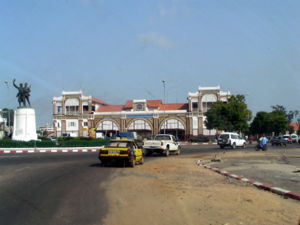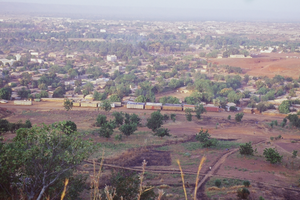Dakar-Niger Railway
The Dakar-Niger Railway connects Dakar, (Senegal) to Koulikoro, (Mali). It serves many cities in Senegal (including Thiès) and Mali (including Kayes, Kita, Kati, Bamako). The line covers a course of 1,287 km of which 641 km lies in Mali.
History
Construction work on the Dakar-Niger Railway began at the end of the 19th century under the French general Gallieni, commander of French Sudan.
The railroad connected the Niger River with the port of Dakar, allowing the transport of raw materials across the globe. The line was completed at the beginning of the 20th century, the Kayes-Koulikoro section being inaugurated in 1904, but the final section of line did not open until 1924.
In 1947, the railroad workers went on a several-month strike to obtain the same rights as the French railwaymen. The successful strike was celebrated as a turning point in the anti-colonial struggle by Senegalese writer Ousmane Sembène in his 1960 novel Les Bouts de bois de Dieu.
With the independence of Mali and Senegal, after the break-up of the Mali Federation, control of the railroad was divided between two national organisations, the Régie des Chemin de fer du Mali (RCFM) and the Régie Sénégalaise.
An agreement between Senegal and Mali in 1962 determined the common exploitation of the line by the two railway companies.
Transrail
The difficulties of management and the lack of investment have led to a degradation of the infrastructure and rolling stock and numerous delays. In October 2003, Senegal and Mali entrusted the management of the network to a Franco-Canadian consortium, Transrail.
In spite of Transrail's obligation to maintain a passenger service, Transrail intends to concentrate on the transport of goods. Many stations have been closed and the numbers of connections reduced, creating difficulties for isolated communities.
Statistics
"Tableau comparative des exportations par rail"[1] No sources are given for any of this data, which shows the number of tons of different products exported in various years:
.
| Product | 1924 | 1934 | 1952-3 | 1955-6 |
|---|---|---|---|---|
| Shelled peanuts | - |
7,422 |
7,250 | - |
| Peanuts in shells | 4,125 | 1,990 | 55,000 |
147,900 |
| Gum arabic | 936 |
1,196 |
1,000 | 1,500 |
| Karité | 416 | 2690 | 9,750 | - |
| Animal skins | 787 |
841 |
10,000 | - |
| Cotton | - | 185 | - | 18,200 |
| Millet | 236 | - | - | 850,000 |
Technical
The railway uses air brakes.
See also
Reference
- Ousmane Sembène, Les bouts de bois de Dieu, Plon, 1960, ISBN 0-435-90959-2.
- ↑ Jean-Claude Faur: La mise en valeur ferroviaire de l'AOF (1880-1939). Paris: Université de Paris, 1969 (=Thesis)


